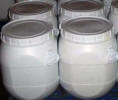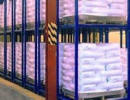| Anmol Chemicals is the pioneer manufacturers of Arsanilic Acid, Pharmaceutical Excipients Chemicals in India. We supply Halal and Kosher Arsanilic Acid made in an ISO9001, ISO22000 (FSSC22000) and cGMP & GLP certified facility. Our group has several manufacturing facilities spread across the world, supported by toll manufacturers and representatives in UAE, Europe, Africa, USA, China and has several associated manufacturing facilities spread across India. All the Information on Physics, Chemistry, Applications, Uses and Technology on Manufacture of Arsanilic Acid is in these pages. |
| The units have one or more of the certifications like FDA GMP, ISO 9001, ISO 22000, HACCP, REACH, Kosher & Halal |




Arsanilic Acid SDS MSDS Sheet of Manufacturers
Arsanilic Acid Specifications of Manufacturers
Arsanilic Acid SDS GHS MSDS Sheet, Material Safety Data Sheet
1. Product Identification
Synonyms: 4-Aminobenzenearsonic acid, 4-Aminophenylarsonic acid, 4-Arsanilic acid
CAS No.: 98-50-0
EINECS: EC Number: 202-674-3
Molecular Weight: 217.05
Chemical Formula: C6H8AsNO3
Relevant Uses: Industrial use only.
Supplier: As per letterhead.
2. Hazards Identification
GHS, Globally Harmonized System Classification in accordance with 29 CFR 1910
Classification according to Regulation (EC) No 1272/2008
Acute toxicity, Oral: Category 3
Serious eye damage/eye irritation Category 2B
Acute toxicity, Inhalation: Category 3
Acute aquatic toxicity: Category 3
Labeling according Regulation (EC) No 1272/2008
GHS Label Elements  Toxic |
GHS Label Elements |
Signal Words: Danger
Hazard Statements:
H301: Toxic if swallowed.
H320: Causes eye irritation.
H331: Toxic if inhaled.
H402: Harmful to aquatic life.
Hazards not otherwise classified (HNOC):
May causes mild skin irritation
May cause mild respiratory irritation
Precautionary Statements:
P301+P310: IF SWALLOWED: Immediately call a POSION CENTER or doctor/physician.
P273: Avoid release to the environment.
P260: Do not breathe dust/fume/gas/mist/vapors/spray.
P262: Do not get in eyes, on skin, or on clothing.
P271: Use only outdoors or in a well-ventilated area.
P264: Wash contaminated parts thoroughly after handling.
P270: Do not eat, drink or smoke when using this product.
P271: Use only outdoors or in a well-ventilated area.
P:273: Avoid release to the environment.
P280: Wear protective gloves/protective clothing/eye protection/face protection.
P312: Call a POISON CENTER or doctor/physician if you feel unwell.
P314: Get medical advice/attention if you feel unwell.
P302+352: IF ON SKIN: Wash with plenty of soap and water.
P304+P340: IF INHALED: Remove victim to fresh air and keep at rest in a position comfortable for breathing.
P305+351+338: IF IN EYES: Rinse cautiously with water for several minutes. P337+P313: If eye irritation persists get medical advice/attention.
Remove contact lenses if present and easy to do – continue rinsing.
P330: Rinse mouth.
P360: Rinse immediately contaminated clothing and skin with plenty of water before removing clothes.
P403+P404: Store in well-ventilated place. Keep container tightly closed.
P405: Store locked up.
P501: Dispose of contents/container in accordance with local/national regulation.
3. Composition/Information on Ingredients
Ingredient: Arsanilic acid
CAS No.: 98-50-0
EINECS: EC Number: 202-674-3
4. First Aid Measures
Always seek medical attention after first aid measures are provided.
Inhalation: Remove to fresh air. If not breathing, give artificial respiration. If breathing is difficult, give oxygen. Get medical attention.
Ingestion: Never give anything by mouth to an unconscious person. Get medical attention.
Skin Contact: Wipe off excess material from skin then immediately flush skin with plenty of water for at least 15 minutes. Remove contaminated clothing and shoes. Get medical attention. Wash clothing before reuse. Thoroughly clean shoes before reuse.
Eye Contact: Immediately flush eyes with plenty of water for at least 15 minutes, lifting lower and upper eyelids occasionally. Get medical attention immediately.
5. Fire Fighting Measures
Auto-Ignition Temperature: Not applicable.
Products of Combustion: Nitrogen oxides (NOx) Carbon monoxide (CO) Carbon dioxide (CO2) arsenic oxides.
Fire: It is not considered to be a fire hazard.
Fire Extinguishing Media: Use water spray, alcohol-resistant foam, dry chemical or carbon dioxide. Use means suitable for extinguishing surrounding fire.
Special Information: In the event of a fire, wear full protective clothing and NIOSH-approved self-contained breathing apparatus with full face piece operated in the pressure demand or other positive pressure mode. At high temperatures or when moistened under fire conditions, it may produce toxic or irritating fumes.
6. Accidental Release Measures
Small Spill: Avoid dust formation. Avoid breathing dust/mist/vapors. Ensure adequate ventilation. Use appropriate tools to put the spilled solid in a convenient waste disposal container. Finish cleaning by spreading water on the contaminated surface and dispose of according to local and regional authority requirements.
Large Spill: It is a poisonous solid. Avoid touching the spilled material. Do not let the product enter drains. Use a shovel to put the material into a convenient waste disposal container. Do not contaminate the environment.
7. Handling and Storage
Do not ingest. Do not breathe dust. Wear suitable protective clothing. In case of insufficient ventilation, wear suitable respiratory equipment.
Avoid contact with skin and eyes. Avoid formation of dust and aerosols. Wash hands thoroughly after handling. Provide appropriate exhaust ventilation at places where dust is formed. If you feel unwell, seek medical attention.
Keep in a tightly closed container, stored in a cool, dry, ventilated area. Protect against physical damage.
8. Exposure Controls/Personal Protection
Airborne Exposure Limits: Permissible Exposure Limit Ontario TWAEV: TWA: 0.01 mg/m3, STEL: 0.05 mg/m3
Ventilation System: A system of local and/or general exhaust is recommended to keep employee exposures as low as possible. Local exhaust ventilation is generally preferred because it can control the emissions of the contaminant at its source, preventing dispersion of it into the general work area.
Personal Respirators (NIOSH Approved): For conditions of use where exposure to dust or mist is apparent and engineering controls are not feasible, a particulate respirator may be worn. For emergencies or instances where the exposure levels are not known, use a full-face positive-pressure, air-supplied respirator.
Skin Protection: Wear protective gloves and clean body-covering clothing.
Eye Protection: Use chemical safety goggles and/or full face shield where dusting or splashing of solutions is possible. Maintain eye wash fountain and quick-drench facilities in work area.
Other Control Measures: Maintain good housekeeping in work area. Dust deposits on floors and other surfaces may pick up moisture and cause the surfaces to become slippery and present safety hazards. Handle in accordance with good industrial hygiene and safety practice. Wash hands after handling.
9. Physical and Chemical Properties
Appearance: Off-white powder.
Odor: It is practically odorless.
Solubility: Very slightly soluble in water.
pH: Not available.
Density: 1.96
Molecular Weight: 217.05
Chemical Formula: C6H8AsNO3
Boiling Point: NA
Melting Point: 230-233C
10. Stability and Reactivity
Stability: Stable under ordinary conditions of use and storage.
Hazardous Decomposition Products: Nitrogen oxides (NOx) Carbon monoxide (CO) Carbon dioxide (CO2) arsenic oxides.
Hazardous Polymerization: Will not occur.
Incompatibilities: Strong oxidizing agent and acids.
Conditions to Avoid: Incompatibles and heat.
11. Toxicological Information
Acute toxicity
Toxic, and may be fatal, if swallowed. Chronic exposure may cause damage to a variety of body organs. Harmful if inhaled. Typical TLV/TWA 0.5 mg m-3.
Toxicity data
Oral, rat: LD50 = >1 gm/kg
Carcinogenic Effects: IARC: Group 1 carcinogen
Mutagenic Effects: Not available.
Teratogenic Effects: Not available.
Other: The hazards associated with arsenic may be seen in this product.
12. Ecological Information
Toxicity to fish: NA
Environmental Toxicity: Very toxic to aquatic organisms, may cause long-term adverse effects in the aquatic environment. The product contains following substances which are hazardous for the environment. May cause long-term adverse effects in the environment. Do not allow material to contaminate ground water system.
BOD5 and COD: Not available.
Toxicity of the Products of Biodegradation: The products of degradation are less toxic than the product itself.
13. Disposal Considerations
Whatever cannot be saved for recovery or recycling should be managed in an appropriate and approved waste disposal facility. Processing, use or contamination of this product may change the waste management options. State and local disposal regulations may differ from federal disposal regulations. Dispose of container and unused contents in accordance with federal, state and local requirements.
14. Transport Information
US DOT, ADR/RID, IMDG & Canada TDG Classification:
UN-Number: 3465
CLASS 6.1
Packing group: III
Identification: ORGANOARSENIC COMPOUND, SOLID, N.O.S.
IATA
UN number: UN3077
UN proper shipping name: Environmentally hazardous substance, solid, n.o.s. (p-Arsanilic acid)
Class 9
Packing group III
Environmental hazards No.
15. Regulatory Information
USA:
SARA 302 Components: No chemicals in this material are subject to the reporting requirements of SARA Title III, Section 302.
SARA 313 Components: This material is subject to the reporting requirements of Section 313 of SARA Title III and 40 CFR Part 373.
SARA 311/312 Hazards: Acute Health Hazard. Chronic Health Hazard.
Canada - DSL/NDSL: Listed on Canada's NDSL List.
Canada - WHMIS: This product has a WHMIS classification of D2A.
Section 16 - Additional Information
Disclaimer:****************************
Our company provides this MSDS sheet in good faith but makes no representation as to its comprehensiveness or accuracy. This SDS sheet is intended only as a guide to the appropriate precautionary handling of the material by a properly trained person using this product. The above information has been compiled from various sources and has the possibility of discrepancy and being out-dated information. Individuals receiving the information must exercise their independent judgment and do further search in determining its appropriateness for a particular purpose. In no case shall our company be liable to loss or damages by the product user.
****************************
Arsanilic Acid Manufacturers
Anmol Chemicals
S-8, SARIFA MANSION, 2ND FLANK ROAD, CHINCHBUNDER, MUMBAI 400009, INDIA
TEL: (OFFICE) 91-22-23770100, 23726950, 23774610, 23723564. FAX: 91-22-23728264
e-mail: anmolc@mtnl.net.in

Exports to USA, Canada, UAE, Dubai, South Africa, Tanzania, Kenya, Nigeria, Egypt, Uganda, Turkey, Mexico, Brazil, Chile, Argentina, Europe Netherlands, Italy, Spain, Germany, Portugal, France, Malaysia, Indonesia, Thailand, Korea, Vietnam, Japan, etc.
Copyright and Usual Disclaimer is Applicable. 31 December, 2021
Barter
They who love thee on this earth, keep calling on thee and chanting thy beads
Lest thou forgetest.
They assign the credit of their hard work to your blessings
They keep you amused.
They come to thy temple with baskets of fruits, as if you were a glutton
They deny the same to their children.
They offer you milk for a bath and burn the ghee
They hardly understand the meaning of it.
They bring gold and diamonds. They come with beating of drums
They love to advertise their offerings.
They offer you a small bribe as advance for booty, called lottery
They love to dream.
I do not bow down at your door
I do not bargain for booty
Your promise of the heaven does not lure me
Your hell-fire does not scare me
I do not even know the proper method of prayer
I do not offer any thing to you
Ages have gone by and I have not seen you my lord
Yet my love for you keeps waiting for you
